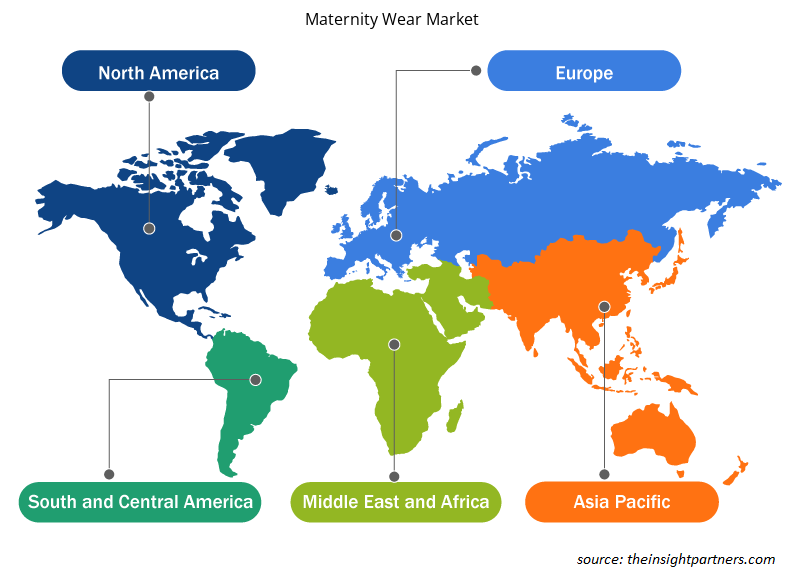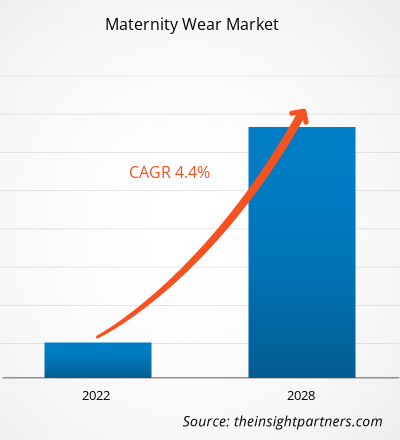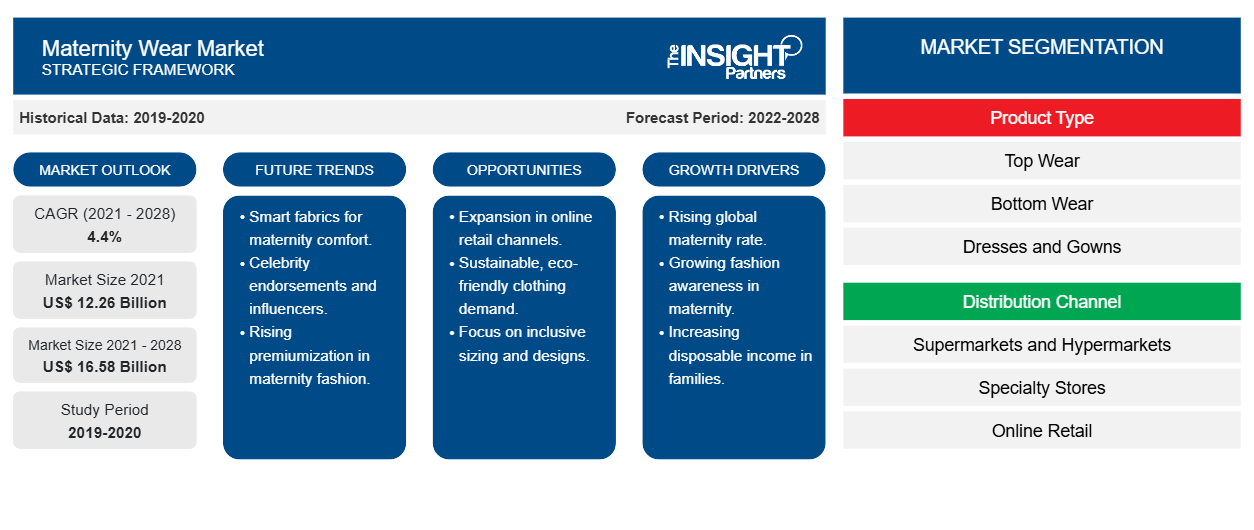Il mercato dell'abbigliamento premaman è stato valutato 12.257,41 milioni di dollari nel 2021 e si prevede che raggiungerà 16.578,64 milioni di dollari entro il 2028; si prevede una crescita a un CAGR del 4,4% dal 2021 al 2028.CAGR of 4.4% from 2021 to 2028.
Gli abiti premaman sono solitamente realizzati con una vestibilità comoda e comoda, dotati di elastici, linguette e tessuti elastici, come elastan e spandex, per offrire maggiore comfort alla consumatrice durante la gravidanza.
L'Asia-Pacifico ha detenuto la quota maggiore del mercato globale dell'abbigliamento premaman nel 2020, mentre si prevede che il Nord America registrerà il CAGR più elevato durante il periodo di previsione. Secondo il rapporto della Banca Mondiale, negli Stati Uniti c'è una media dell'85% di donne lavoratrici incinte. Pertanto, la domanda di abbigliamento premaman e taglie forti nell'abbigliamento formale nella sezione abiti e abiti da sera formali è in aumento. Questo è un fattore importante che contribuisce alla crescita del mercato dell'abbigliamento premaman in Nord America.
Impatto della pandemia di COVID-19 sul mercato dell'abbigliamento premaman
La pandemia di COVID-19 ha avuto effetti negativi su molti settori, tra cui quello dei beni di consumo. La pandemia ha creato difficoltà operative dovute a lockdown, chiusure aziendali e interruzioni della catena di fornitura. I negozi al dettaglio di abbigliamento e vestiario hanno registrato perdite elevate nelle vendite. I risultati finanziari pubblicati da marchi di moda come lo spagnolo Inditex Group e lo svedese H&M hanno messo a nudo l'enormità dell'impatto della pandemia. Inoltre, l'e-commerce ha tratto un beneficio duraturo dalla pandemia, poiché la maggior parte degli acquirenti online considera l'e-retail come un'opzione post-pandemia. Inoltre, si prevede che l'aumento dei tassi di vaccinazione, la ripresa delle attività manifatturiere e l'allentamento delle normative governative influenzeranno positivamente il mercato globale dell'abbigliamento premaman durante il periodo di previsione.
Personalizza questo report in base alle tue esigenze
Riceverai la personalizzazione gratuita di qualsiasi report, comprese parti di questo report, o analisi a livello nazionale, pacchetto dati Excel, oltre a usufruire di grandi offerte e sconti per start-up e università
-
Scopri le principali tendenze di mercato in questo rapporto.Questo campione GRATUITO includerà analisi di dati che spaziano dalle tendenze di mercato alle stime e alle previsioni.
Approfondimenti di mercato
L'adozione di strategie di crescita aziendale stimola la crescita del mercato
I player affermati nel mercato adottano varie strategie per superare le sfide attuali e future per l'espansione dell'azienda. Ad esempio, Isabella Oliver ha adottato una strategia di penetrazione del mercato lanciando un programma di noleggio di abiti premaman per migliorare la propria portata. Il 20 gennaio 2020, il marchio ha nuovamente lanciato un nuovo programma di noleggio per diventare circolare e aumentare la longevità degli abiti premaman. Isabella Oliver ha offerto ai suoi clienti la nuova gamma di opzioni per noleggiare un abito, inclusi abiti da festa e articoli essenziali per la gravidanza, per due settimane, prima di restituirlo gratuitamente. Il marchio si occupa persino della pulizia a secco. I clienti possono anche acquistare il prodotto. L'idea di noleggiare abiti premaman è quella di incoraggiare i clienti a diventare più ecologici ed eliminare gli effetti della fast fashion. Quindi, le innovazioni e le penetrazioni del prodotto hanno portato a un aumento della domanda di abiti premaman. Questi fattori stanno guidando la crescita del mercato dell'abbigliamento premaman.
Informazioni sui canali di distribuzione
In base al canale di distribuzione, il mercato dell'abbigliamento premaman è segmentato in supermercati e ipermercati, negozi specializzati, vendita al dettaglio online e altri. Si prevede che il segmento della vendita al dettaglio online registrerà il CAGR più elevato durante il periodo di previsione. L'e-commerce ha svolto un ruolo fondamentale durante i mesi iniziali della pandemia di COVID-19, poiché ai negozi al dettaglio fisici non era consentito operare. Durante i lockdown, le persone hanno utilizzato sempre di più le piattaforme di e-commerce per acquistare prodotti essenziali e non essenziali. La crisi economica dovuta allo scoppio del COVID-19 ha comportato una riduzione del reddito disponibile delle donne. Tuttavia, la domanda di abbigliamento premaman non è stata influenzata. Di conseguenza, è probabile che i prezzi competitivi diventino una caratteristica fondamentale dell'intero panorama in futuro. Si prevede che questo fattore rafforzerà potenzialmente la crescita del mercato per il segmento della vendita al dettaglio online durante il periodo di previsione.CAGR during the forecast period. E-commerce played a vital role during the initial months of the COVID-19 pandemic, as physical retail stores were not permitted to operate. During lockdowns, people increasingly used e-commerce platforms to buy essential and nonessential products. The economic crisis due to the COVID-19 outbreak resulted in reduced disposable incomes of women. However, the demand for maternity wear was not affected. As a result, competitive pricing is likely to become a key feature of the complete landscape in the future. This factor is projected to potentially bolster the market growth for the online retail segment during the forecast period.
Informazioni sul tipo di prodotto
In base al tipo di prodotto, il mercato dell'abbigliamento premaman è suddiviso in top wear, bottom wear, abiti e abiti da sera e biancheria intima . Il segmento top wear ha rappresentato una quota di mercato maggiore nel 2020 e si prevede che il segmento abiti e abiti da sera registrerà un CAGR più elevato durante il periodo di previsione. L'abbigliamento premaman è composto da abbigliamento formale e casual. Inoltre, la domanda di abbigliamento premaman formale è in aumento a causa del crescente numero di donne lavoratrici. L'abbigliamento premaman formale è composto da kurti, camicette, abiti canotta in materiale morbido, blazer e trench con doppio strato. L'abbigliamento casual comprende tuniche, maxi abiti e felpe e t-shirt oversize. Gli abiti premaman sono realizzati con tessuti della migliore qualità con materiali naturali e confortevoli, come cotone, modal e bambù , poiché sono morbidi e consentono una respirazione costante. Le donne incinte tendono a scegliere il materiale in base ai cambiamenti stagionali. In estate, preferiscono tessuti di lino termorepellenti per un facile flusso d'aria, mentre in inverno, sono preferiti cappotti di lana caldi per prevenire il freddo.
Tra i principali attori del mercato dell'abbigliamento premaman ci sono Gap Inc, Seraphine, Isabella Oliver, H and M Hennes e Mauritz AB, Brunelli and Co SRL, Mothercare, Boob Design, SHAICO Fashion Pvt. Ltd, Pink Blush Maternity e Organic & More.
Approfondimenti regionali sul mercato dell'abbigliamento premaman
Le tendenze regionali e i fattori che influenzano il mercato dell'abbigliamento premaman durante il periodo di previsione sono stati ampiamente spiegati dagli analisti di Insight Partners. Questa sezione discute anche i segmenti e la geografia del mercato dell'abbigliamento premaman in Nord America, Europa, Asia Pacifico, Medio Oriente e Africa e Sud e Centro America.

- Ottieni i dati specifici regionali per il mercato dell'abbigliamento premaman
Ambito del rapporto sul mercato dell'abbigliamento premaman
| Attributo del report | Dettagli |
|---|---|
| Dimensioni del mercato nel 2021 | 12,26 miliardi di dollari USA |
| Dimensioni del mercato entro il 2028 | 16,58 miliardi di dollari USA |
| CAGR globale (2021 - 2028) | 4,4% |
| Dati storici | 2019-2020 |
| Periodo di previsione | 2022-2028 |
| Segmenti coperti |
Per tipo di prodotto
|
| Regioni e Paesi coperti |
America del Nord
|
| Leader di mercato e profili aziendali chiave |
|
Densità degli attori del mercato: comprendere il suo impatto sulle dinamiche aziendali
Il mercato del mercato dell'abbigliamento premaman sta crescendo rapidamente, spinto dalla crescente domanda degli utenti finali dovuta a fattori quali l'evoluzione delle preferenze dei consumatori, i progressi tecnologici e una maggiore consapevolezza dei vantaggi del prodotto. Con l'aumento della domanda, le aziende stanno ampliando la propria offerta, innovando per soddisfare le esigenze dei consumatori e capitalizzando sulle tendenze emergenti, il che alimenta ulteriormente la crescita del mercato.
La densità degli operatori di mercato si riferisce alla distribuzione di aziende o società che operano in un particolare mercato o settore. Indica quanti concorrenti (operatori di mercato) sono presenti in un dato spazio di mercato in relazione alle sue dimensioni o al valore di mercato totale.
Le principali aziende che operano nel mercato dell'abbigliamento premaman sono:
- Gap Inc
- Serafina
- Isabella Oliver
- H & M Hennes e Maurits
- Brunelli & Co. SRL
Disclaimer : le aziende elencate sopra non sono classificate secondo un ordine particolare.

- Ottieni una panoramica dei principali attori del mercato dell'abbigliamento premaman
Segnala i riflettori
- Tendenze progressive del settore nel mercato dell'abbigliamento premaman per aiutare gli operatori a sviluppare strategie efficaci a lungo termine
- Strategie di crescita aziendale adottate dai mercati sviluppati e in via di sviluppo
- Analisi quantitativa del mercato dell'abbigliamento premaman dal 2019 al 2028
- Stima della domanda globale di ingredienti lattiero-caseari
- Analisi delle cinque forze di Porter per illustrare l'efficacia degli acquirenti e dei fornitori che operano nel settore
- Sviluppi recenti per comprendere lo scenario competitivo del mercato
- Tendenze e prospettive del mercato, nonché fattori che guidano e frenano la crescita del mercato dell'abbigliamento premaman
- Assistenza nel processo decisionale evidenziando le strategie di mercato che sostengono l'interesse commerciale, portando alla crescita del mercato
- La dimensione del mercato dell'abbigliamento premaman in vari nodi
- Panoramica dettagliata e segmentazione del mercato, nonché dinamiche del settore dell'abbigliamento premaman
- Dimensioni del mercato dell'abbigliamento premaman in diverse regioni con promettenti opportunità di crescita
- Analisi storica (2 anni), anno base, previsione (7 anni) con CAGR
- Analisi PEST e SWOT
- Valore/volume delle dimensioni del mercato - Globale, Regionale, Nazionale
- Industria e panorama competitivo
- Set di dati Excel
Report recenti
Rapporti correlati
Testimonianze
Motivo dell'acquisto
- Processo decisionale informato
- Comprensione delle dinamiche di mercato
- Analisi competitiva
- Analisi dei clienti
- Previsioni di mercato
- Mitigazione del rischio
- Pianificazione strategica
- Giustificazione degli investimenti
- Identificazione dei mercati emergenti
- Miglioramento delle strategie di marketing
- Aumento dell'efficienza operativa
- Allineamento alle tendenze normative























 Ottieni un campione gratuito per - Mercato dell'abbigliamento premaman
Ottieni un campione gratuito per - Mercato dell'abbigliamento premaman